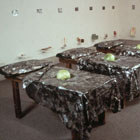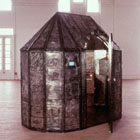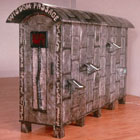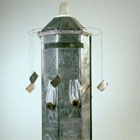JANE GILMOR
artwork | audio | statement | galleries
artwork
audio 
(see also Making Art in Iowa)
- School (46 sec. | 317KB): listen | read
- Describing artwork (58 sec. | 400KB): listen | read
- Public art (37 sec. | 259KB): listen | read
- Windows (35 sec. | 241KB): listen | read
- Rhythm of work (18 sec. | 130KB): listen | read
- Advice to new artists (34 sec. | 234KB): listen | read
artist statement
My recent installations and sculptures combine fabricated objects, found text, and incised metal foil with audio and video to explore issues of identity, dislocation and the construction of memory. My focus is on those slippages and entanglements of image, language, and space through which we try to locate our own identity. Among these random collisions, I search for some unspoken connection. For me these environments function as shrines to the extraordinary nature of the ordinary life, embodying its most peculiar, ridiculous, and meaningless(ful) qualities.
audio text
School
When I was in high school, I was really interested in art. But at that point I was also a good student in other things, and it was just looked down upon to take art instead of like advanced trig or something. So I didn't take art again till I was a senior in high school. And it was my nemesis because—well, I didn't think I should go to college in art because it wasn't practical.
My art teacher, Mrs. Loomis—she was really the one who would take me aside. I always liked to wear like really funky clothes and stuff, and she would just say, "You have got something, dear," you know. And she was really great. And I could draw things real realistically, but it didn't interest me that much, and that's not usually the kind of thing that gets encouraged. So, I was very lucky to have her, because she recognized a different value in my work that I don't know would have been recognized—sort of the expressive content and stuff.
Describing artwork
I'm a good synthesizer, borrower, rip-off. I find things. I really I think I'm a storyteller in a sense, although they're never real overt narratives, and other people don't usually know what the story is—or often they don't, depending on whether it's a public art piece or not. I use a lot of different media. Installation art is such a broad category, so I would say that I'm one who likes to arrange objects in a space to create some kind of meaning. I like, also, things that are a little obscure or they make new relationships for other people, and they may not be the same for everybody.
I think it's always been based on personal experience, but on telling stories in a way where there's a kind of absurdity that lends itself to everybody's experience. Some of the later public pieces aren't very funny because the topics just aren't funny—but most of my work has this kind of questioning. So, I think I just, like, raise a lot of questions that I can't answer.
Public art
All the public pieces are meant to be seen by the people who made them and the people in that environment more than in a museum. The technique itself—drawing and writing on this metal surface—I like it, because it looks so precious and it's not. It's heavier than tin foil, but it's nothing important, but it looks important, and so it has that kind of irony about it.
And when I started working with the homeless, I didn't really want to use this material, because I thought, "This is like romanticizing homelessness." But I asked them what they thought—they all keep one of them and then they make another one to go on there—and they were just like, "No, this is about the only permanent thing I have in my life." And they said, "Oh, other people will see their reflections in our notes." I mean that's one thing one guy said, it's so brilliant. So, I kept using it.
Windows
I always wanted to do something at University Hospitals in the Pediatrics because my sister died there. So I did this project called Windows in Pediatrics there. And then put it up there. The structure was kind of a collaboration between myself and a former student who builds things for me, Rick Edelman, who is a brilliant artist himself.
It's public art in a different sense. Rather than public art, art by an artist put somewhere—it's public art where the people have participated in the construction of it, and so forth. The other thing is that it's really like a shrine—the inside and the outside of it, and where you go in and write. It was very successful in that sense.
Rhythm of work
The rhythm of the work is sometimes really wonderful—like I could just work for hours—but then there's a lot of times when it's not, and you just have to keep going. I would say that's very often the case.
There are times when I can't work much at all, but at least I've lived through that part where you think you're not an artist for half a year because you haven't done anything. It comes back, so that doesn't worry me like it used to.
Advice to new artists
First of all, you've got to be really committed and want to work really hard, and then if you're going to do that, you should really just put everything into it.
How one is an artist in one's life can vary. You can keep on making things and not be a famous artist. There's a definite track. If you want to be a famous artist, you've got to do this, this, and go to these schools and live here and that's that. That's the way it works—and in fact more now than it used to be. So, you have to more make the decision of what kind of artist you want to be, and how you want to discipline yourself or not discipline yourself, and whether you want to educate yourself so that you get more stimulus.
But I would say, do it—why not, you never know!





